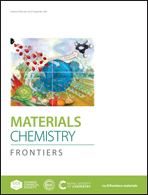Hexagonal petal-like cobalt oxide nanowire arrays encapsulated by MOF-derived Co/N-codoped carbon for boosting electrochemical capacitor behaviour†
Abstract
The use of transition metal oxides (TMOs) as electrode materials remains challenging because TMOs undergo volume expansion during energy storage. In this work, a core–shell heterostructured nanowire array-assembled hexagonal petal-like CoO encapsulated by MOF-derived Co/N co-doped carbon composite (NF@CoO@Co/N–C) was synthesized on a conductive substrate (Ni foam, NF) using a zeolitic imidazolate skeleton (ZIF-67) as the template via “anchor-etch-calcine” processes. The synergetic function of the heteroatom co-doping, the in-site encapsulation of the carbon matrix, and the unique structural characteristics largely enhance the electrochemical performance. As expected, the NF@CoO@Co/N–C electrode material exhibits an ultrahigh areal capacitance, which is at least two-fold that of its corresponding transition metal oxide. Finally, an asymmetrical-solid-state supercapacitor (ASC) fabricated by NF@CoO@Co/N–C and activated carbon with high volumetric capacity (11.06 F cm−3), high energy density (5.05 mW h cm−3) and a long-term cyclability is demonstrated (94.5% capacitance retention after 10 000 cycles at 10 mA cm−2). This study provides rational guidance toward the design of TMOs electrode materials with extended-life energy storage performance.



 Please wait while we load your content...
Please wait while we load your content...